**  USA Customers: Enjoy up to $800 Tax Free Imports - Even with Tariffs, we're still better value than US stores! **
USA Customers: Enjoy up to $800 Tax Free Imports - Even with Tariffs, we're still better value than US stores! **
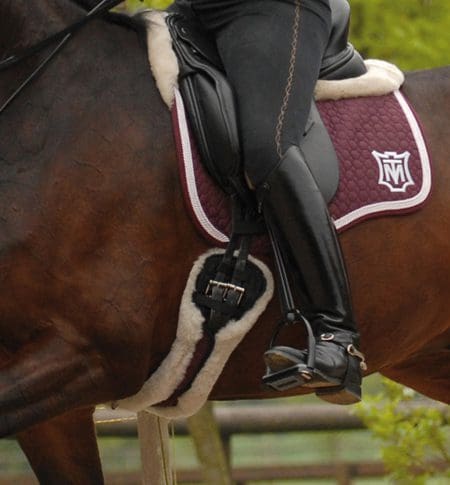
Few things are more frustrating, or potentially dangerous, than a saddle that won’t stay in place. Whether it’s slipping forward, sliding sideways, or shifting back during a ride, saddle movement affects your balance, disrupts your horse’s comfort, and can seriously hinder performance.
The instinct is often to tighten the girth, but that rarely solves the problem. In many cases, it actually makes things worse by increasing pressure behind the elbows, leading to soreness, tension, and resistance. The real solution usually comes down to fit, conformation, and—most importantly using the right girth for your horse’s individual shape and movement.
In this article, we’ll explore the best girths for slipping saddles, along with other proven tools to help you achieve a more stable, secure fit. And this isn’t just theory—we’ll share real-world examples of common girthing issues we’ve helped riders resolve, so you can see exactly how and why these solutions work.
We’ll also explain why saddle fit isn’t static. As horses gain or lose weight, develop muscle, or change throughout the season, even a correctly fitted saddle can start to slip. That’s why we’ll also look at additional tools, like adjustable pad systems—that work in harmony with the right girth to keep your saddle exactly where it should be.
Let’s take a closer look at what causes saddle slipping in the first place, and more importantly, how to stop it.
Before we look at saddle slipping issues that can be corrected by girths and correction pads, it’s worth acknowledging that not all saddle slipping issues are caused by the girth. In fact, there are a number of other factors that can lead to an unstable saddle, and unless these are ruled out, even the most perfectly fitted girth won’t completely solve the problem.
Here are the most common non-girth-related causes of saddle movement. If any of these apply to your situation, they may need to be addressed before (or alongside) investing in a new girth or pad.
Too far forward: If the saddle is placed over the shoulder, it can restrict movement and be pushed back as the horse works.
Too far back: The girth ends up pulling it forward from an unstable position, creating tension and imbalance.
🟡 Solution: Check that the saddle is positioned behind the shoulder blade, sitting in the natural saddle pocket. If in doubt, consult a saddle fitter.
Too loose: The saddle will naturally shift, even if everything else is correct.
Too tight: Causes discomfort, which can make the horse hollow or resist, leading to slipping or rotation.
Girth in the wrong place: Misalignment with the natural girth groove can pull the saddle forward or off centre.
🟡 Solution: Girth evenly on both sides, double-check the groove alignment, and avoid over-tightening. Always girth with the horse standing square and relaxed.
Tree too wide or narrow: Creates instability as the saddle floats or perches.
Saddle too long: Extends beyond the weight-bearing area and encourages backward movement.
Uneven panels or flocking: Can cause lateral tilt, which encourages the saddle to drift.
Saddle sits too high off the back: Reduces contact, increasing instability.
🟡 Solution: Have your saddle checked by a qualified fitter. Minor issues can often be corrected with re-flocking, adjustments, or shimming.
Uneven seat or poor posture: A rider who collapses a hip, leans, or grips unevenly can shift the saddle laterally.
Uneven stirrup lengths: Even a small difference can cause a persistent saddle tilt.
🟡 Solution: Work with a coach to assess your balance and posture. Use video if needed. Check your tack setup regularly for symmetry.
Asymmetrical shoulders or back: Common in young or developing horses. One shoulder larger than the other can pull the saddle across.
Changing muscle tone: Horses coming out of winter, starting work, or changing condition throughout the season may cause fit issues.
🟡 Solution: Track your horse’s condition and saddle fit over time. Flexible solutions like shimmable pads or adjustable saddles can help during these phases.
Further Reading: Why Is My Saddle Slipping? – FEI/Bates Saddles
Not all saddle slipping can (or should) be fixed with a new girth. The first step is understanding the true cause. Once you’ve ruled out tack placement, rider habits, and saddle fit, you’ll be in a much better position to solve the problem permanently.
Next, we’ll focus on the best girths for slipping saddles. Saddles that slip caused by conformation problems and the girthing solutions that really work.
When it comes to finding girths to stop saddle slipping, the shape of your horse matters more than most riders realise. In addition to the issues we’ve discussed above, many girthing problems stem from a horse’s conformation — and standard straight girths, “anti slip horse girths”, or even some so-called “anatomical” designs, simply can’t accommodate the wide range of body shapes and movement patterns we see in real horses.
Sadly, not all anatomical girths are created equal. But after years of fitting girths for hundreds of horses with every kind of conformation challenge, we’ve found that one brand consistently offers the best girth to stop saddle slipping and the results speak from themselves.

That company is Mattes. Mattes girths aren’t just padded or shaped for appearances, they’re engineered. Developed in conjunction with top European riders and tested on horses of every type, each Mattes girth is purpose-built to eliminate specific saddle movement issues. From forward girth grooves to round barrels and athletic builds, these girths are designed to fix the root cause of slipping, without over tightening, without compromise, and without adding pressure behind the elbows.
They’re also the only girths we recommend, because they’re the only ones that consistently solve the problems our customers bring to us.
We understand that Mattes girths aren’t the cheapest option, especially when many generic girths start around £50. A properly fitted Mattes girth typically costs around £200 — but when you consider the long-term comfort, stability, and performance gains, it’s definitely an investment worth making.
If a girth can stop your saddle from slipping, improve your horse’s way of going, and prevent pressure-related issues, then it’s not just a piece of tack — it’s a solution. And with our expert fitting advice (and a free exchange guarantee if the shape isn’t quite right), you’re never taking a risk.
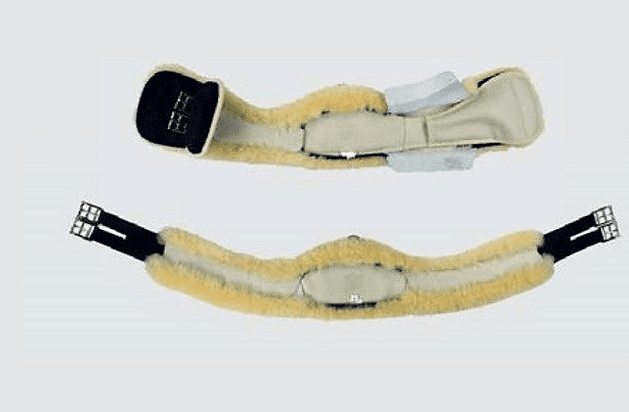
The Mattes crescent girth is Best for:
* Round-barrelled horses
* Short backs with no defined girth groove
* Wide ribs or narrow chests
* Ponies with curved girthing areas

Solves:
* Saddle and girth slipping forward
* Pressure behind the elbows
* Rubbing around the elbow area
* Poor girth anchoring on rotund builds
How it works:
The Crescent girth is shaped like a shallow bowl curving forward that wraps around the ribcage, hugging the shape of the horse and preventing the girth from sliding forward by absorbing the natural curve of the barrel, anchoring the saddle without pulling.
Available styles:
* Short (dressage and monoflap saddles) and long general purpose and jumping saddles
* Western cinch version for western saddles
* Long and Short Version for Jumping Saddles
* Cotton Quilt with removable lambskin cover
* Slimline leather padded body with removeable lambskin cover (2cm narrower)
* Special Pony Version
Over the past few years, we’ve helped many customers solve persistent saddle slipping issues, not through guesswork, but by carefully matching the right girth shape to the horse’s conformation, or to address a specific problem. Below are just a few examples where choosing the correct Mattes girth made all the difference.
🟣 Real Example – Kate’s pony
Kate had tried everything from LeMieux to Fairfax girths and even added sheepskin and Vaseline, but nothing stopped the girth from moving forward when her pony gained weight and as you can see from the photos, the current girth was sitting very close to the elbows. The Mattes Short Slimline Crescent girth finally solved the problem. No slipping, no rubs, just a secure, comfortable ride.
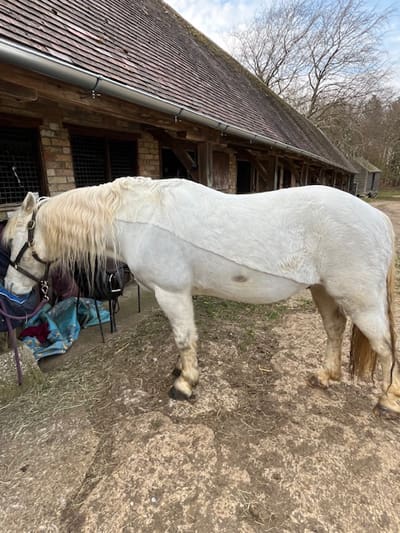
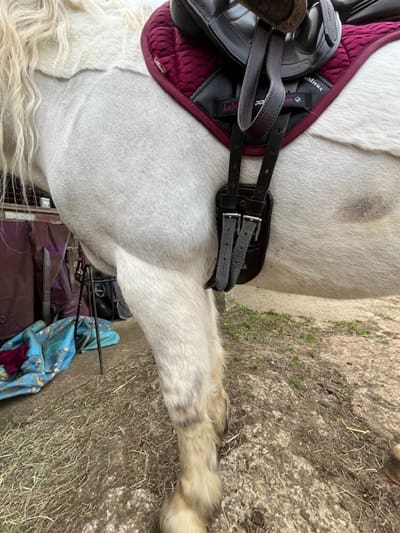
🟣 Real Example – My Daughters Pony
My Daughters pony had a similar issue — a round shape and forward girth groove. After switching to the Special Pony Crescent Girth, the saddle stayed in place and the improvement in his performance was immediate.
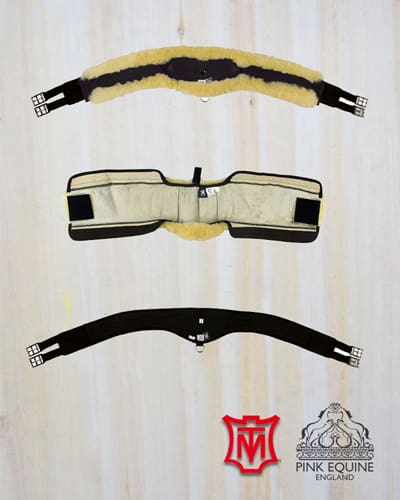
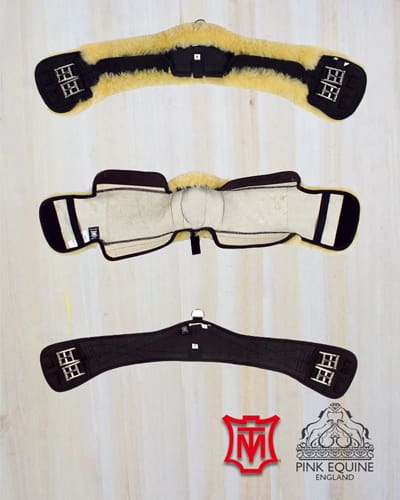
The Mattes Athletico Girth is Best for:
* Sporty, wedge-shaped horses
* Muscular builds with a sloping underline
* Horses that push the saddle backward

Solves:
* Saddle slipping backwards
* Girth sliding back toward the flanks
* Saddle instability on narrow-hipped or fit horses
How it works:
The Athletico girth is cut to “catch” the girth groove on wedge-shaped horses and prevent backward movement. The shape provides firm forward anchoring while still avoiding pressure zones.
Available styles:
* Short (dressage and monoflap saddles) and long general purpose and jumping saddles
* Western cinch version for western saddles
* Long and Short version for Jumping Saddles
* Cotton Quilt with removable lambskin cover
* Slimline leather padded body with removeable lambskin cover (2cm narrower)
🟣 Real Examples – Laura & Shannon
Both horses had backward saddle slippage, even after trying multiple girths and saddle adjustments. We recommended the Short Slimline Athletico Girth to resolve the movement and, in Laura’s case, eliminated girth sores altogether.
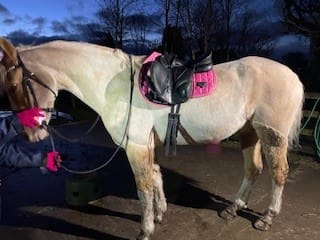
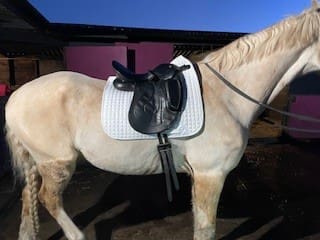
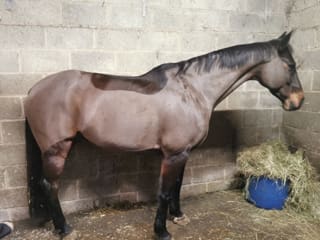
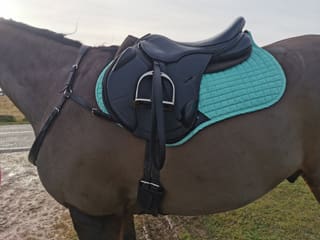
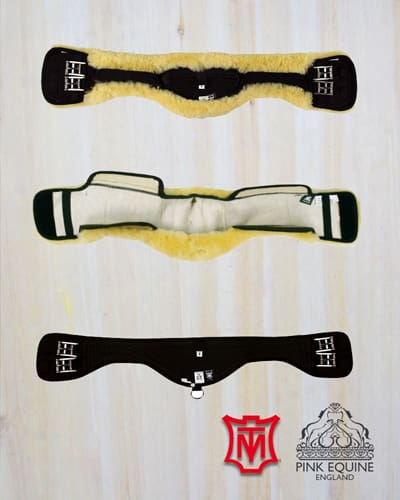
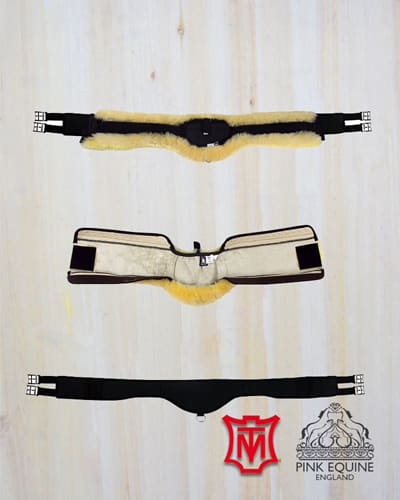
Mattes Asymmetric Girths Best for:
* Horses with a forward girth groove
* Deep-chested horses with little space behind the elbow
* Long-backed horses where girth placement drifts forward

Solves:
* Saddle/girth being pulled forward
* Rubbing behind elbows
* Pressure under the belly and girth instability
How it works:
The Asymmetric girth has a deeply contoured shape in front of the elbow, allowing it to sit back in the girth groove without pulling forward. It’s ideal when the distance between the girth groove and elbow is minimal.
Available styles:
* Short (dressage and monoflap saddles) and long general purpose and jumping saddles
* Western cinch version for western saddles
* Long and Short version for Jumping Saddles
* Cotton Quilt with removable lambskin cover
* Slimline leather padded body with removeable lambskin cover (2cm narrower)
🟣 **Real Example – Zoe**
Her horse experienced girth rubs and saddle slipping forward with multiple brands. The **Long Asymmetric Slimline Girth** positioned the girth correctly behind the elbows and completely resolved the issue.
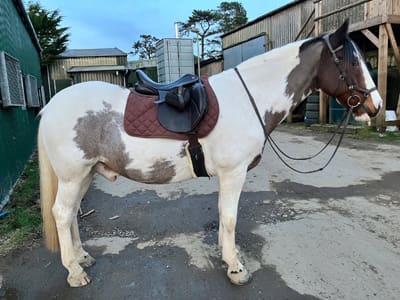
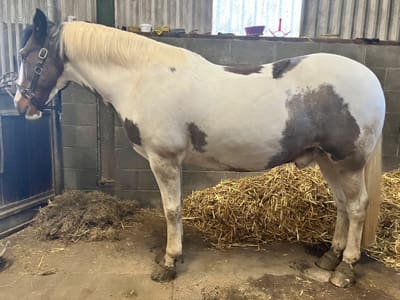
div class=”blog-post__article-images”>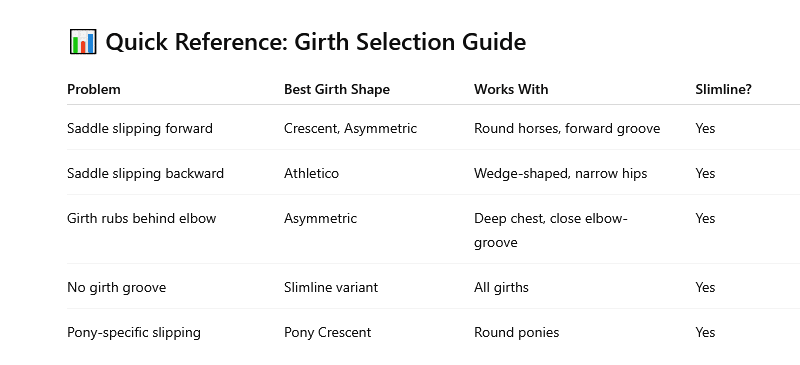
Every Mattes girth — regardless of shape — is built with:
* Internal pressure distribution plates to spread girth tension
* Contoured shaping for freedom behind the elbow
* Removable lambskin lining for cushioning and breathability
* A choice of quilt padding or leather-padded slimline, depending on fit requirements
The Slimline version is 2cm narrower and works especially well when your horse has no visible girth groove, or there’s minimal space between girth and elbow.
Unlike other retailers, we don’t guess. If we recommend a specific girth shape based on your horse and it doesn’t work, **we’ll replace it free of charge** with a more suitable model. That’s how confident we are — and it’s why we have a 99.9% success rate in girth fittings.
Need help choosing the right shape for your horse?
Start your free girth consultation today — no pressure, just good advice.
Even with the perfect girth, there’s one more factor that can affect saddle stability — your horse’s changing shape. Throughout the year, your horse’s condition may fluctuate:
A little rounder coming out of winter
Leaner and more muscled during competition season
Changes in training, injury recovery, or age can all affect topline and symmetry
These natural changes can shift how your saddle fits, which in turn can cause it to tip, rock, or slip — even if it was professionally fitted at the start of the season.
But calling out your saddle fitter every time your horse changes shape isn’t always practical or affordable. That’s exactly why Mattes created their patented Correction System, a smart, adjustable solution designed to fine-tune saddle fit as your horse develops.
The Mattes Correction System is built into specially designed saddle pads and half pads. It uses a series of discreet pockets along the pad’s underside that hold thin felt shims. These shims can be added, removed, or adjusted individually at the front, middle, or rear of the pad to balance the saddle laterally and longitudinally.
So if your saddle is:
Tipping forward or back
Listing to one side
Not sitting level across the spine
You can simply adjust the number of shims in the affected zone to create a more even, stable surface, no saddle reflocking needed.
It’s particularly useful when working with young horses, horses coming back into work, or riders managing conformation quirks like uneven shoulders or back asymmetry.
If your saddle is slipping because of minor changes in your horse’s build, especially if those changes are seasonal or temporary, then the Correction System, used alongside the right girth, can be the missing piece of the puzzle.
We’ll be publishing a full guide to the Mattes Correction System soon, but it’s worth mentioning here because in many cases, this system is what takes a good fit to a perfect one — and keeps the saddle in place without repeated refits. In the meantime feel free to a look at some of the Mattes range of Saddle pads and Half pads with the correction system.
If your saddle keeps slipping, it’s not just frustrating, it can impact your horse’s comfort, your position, and your performance. While many riders instinctively reach for tighter girthing, the truth is: solving the problem starts with understanding the cause.
From saddle placement and fit, to rider posture and horse conformation, we’ve explored the full picture. And when the issue comes down to your horse’s shape, choosing the right anatomical girth, matched carefully to the problem can make all the difference.
That’s why we only recommend Mattes girths. Their proven designs, expert engineering, and unbeatable comfort have solved girthing issues for hundreds of our customers (and our own horses too).
And if saddle fit is being affected by seasonal shape changes or asymmetry, the Mattes Correction System offers a flexible, affordable way to restore balance, without needing a complete saddle refit.
We offer a free personalised girth consultation to help you find the right shape for your horse. No guesswork. No pressure.
✓ Expert advice
✓ 99% fit success rate
✓ And if it’s not right, we’ll replace it — free of charge.
Start your free girth consultation now
Your horse deserves comfort. You deserve confidence. Let’s fix it — together.
A slipping saddle can be caused by multiple factors, including poor saddle fit, incorrect placement, uneven rider posture, or your horse’s conformation. A forward girth groove, round barrel, or wedge-shaped build can all make it harder to keep a saddle stable, especially when using a generic or straight girth.
Not necessarily. Overtightening can actually cause discomfort or resistance, making the problem worse. If the saddle or girth isn’t correctly matched to your horse’s shape, tightening it won’t fix the root issue, and can lead to pressure sores or behavioural problems.
That depends on your horse’s conformation.
For round-barrelled horses with no defined girth groove, the Mattes Crescent girth is often ideal.
For forward girth grooves and deep chests, the Asymmetric shape works well.
Mattes also offer a special pony Crescent girth for smaller horses with similar build types.
A saddle that slips backward is often caused by a wedge-shaped, narrow-hipped horse. The Mattes Athletico girth is designed to anchor the girth forward and stop the saddle from drifting back — especially helpful for fit, muscled horses with sloping underlines.
Yes — in some cases. If your saddle fit is only slightly off due to seasonal changes, fitness, or asymmetry, the Mattes Correction System allows you to adjust balance using shims in a saddle pad or half pad. It’s an ideal solution for maintaining saddle position without the cost of a full refit.
Absolutely. While Mattes girths aren’t cheap, they’re built to solve complex saddle stability problems — not just cushion the area. With internal pressure plates, anatomical shaping, and removable lambskin lining, they’re an investment in your horse’s comfort and long-term performance.
We offer a free girth consultation to help you choose the right one the first time. And if the girth doesn’t fit or solve your problem, we’ll replace it with a more suitable option — free of charge.